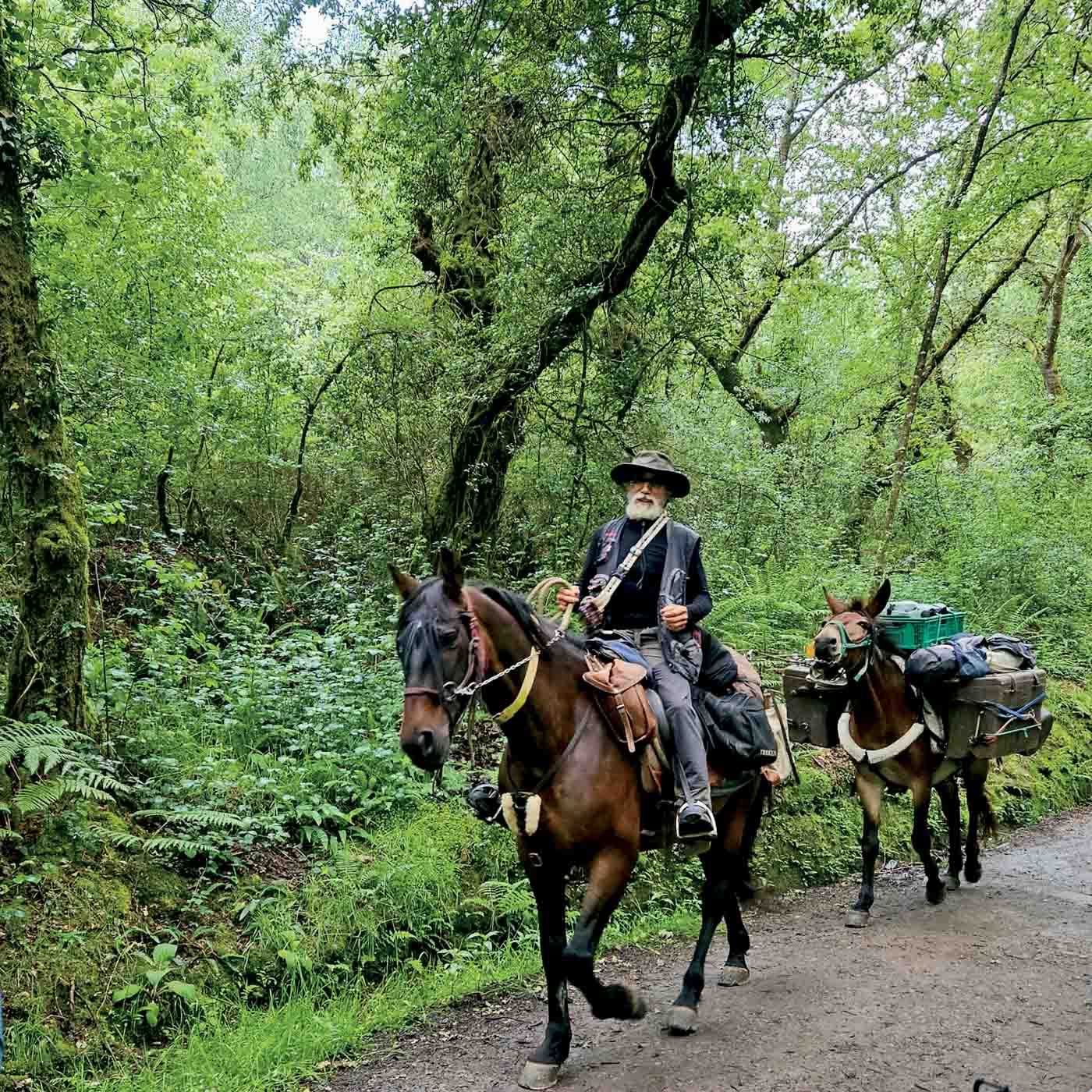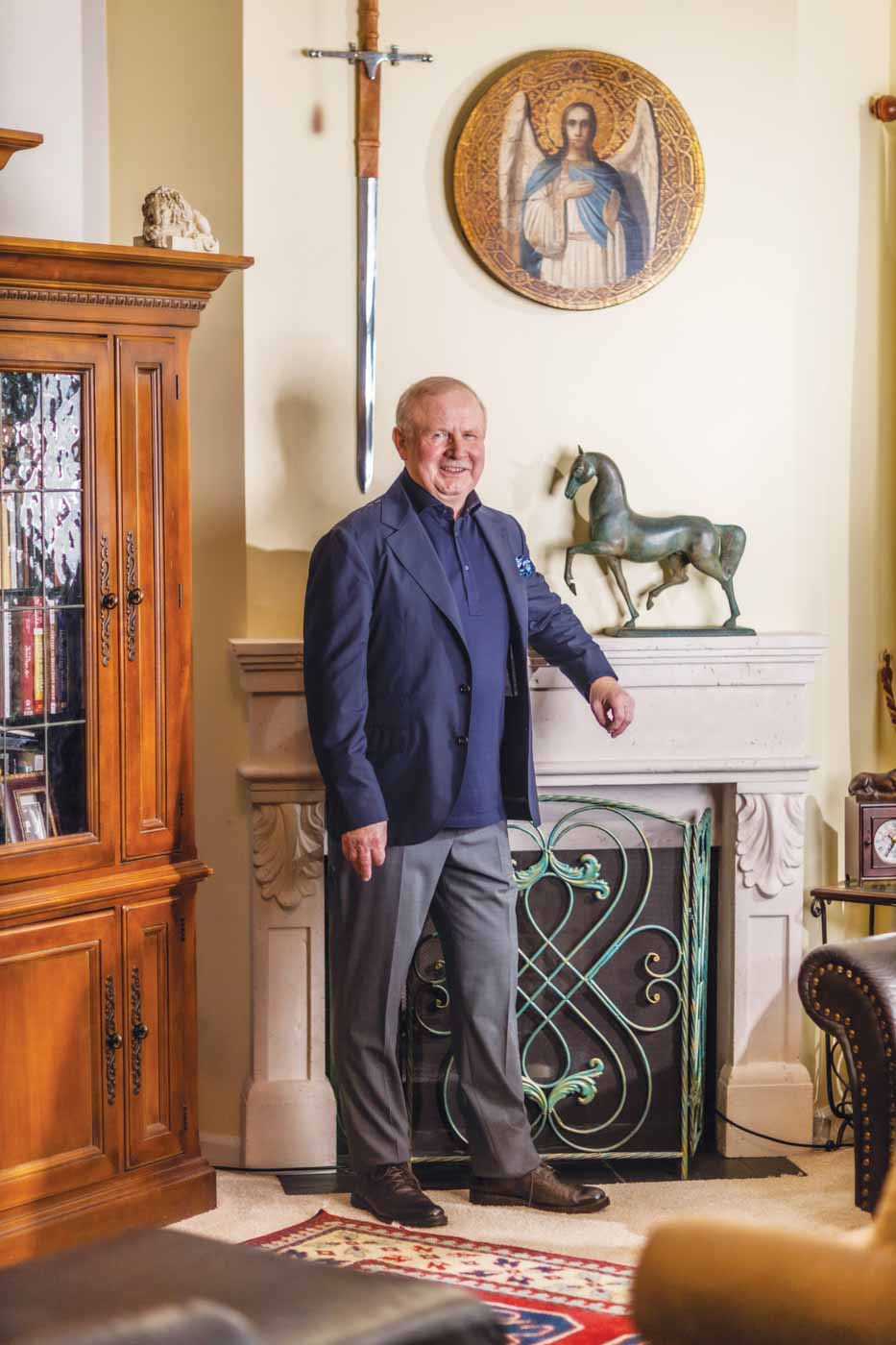621 MILES, 28 DAYS
By Wendy Altschuler
With walking sticks Glowacki in his element, wearing Theory pants and navy half zip sweater, neimanmarcus.com.
By Wendy Altschuler
With walking sticks Glowacki in his element, wearing Theory pants and navy half zip sweater, neimanmarcus.com.

At age 65, Kai Glowacki, a Barrington local, knew he wanted a challenge that was not so much of a goal as it was a must-do journey. “It simply was a matter of time,” Glowacki says. “And finally, in 2023, it was that time, and I am very happy I accomplished it. It is said that you walk the Camino after a loss of a loved one, or when you’re in a crossroads in life. For me, it was a long time longing, and with the loss of my mom in November 2022, the Camino was calling, and I had to go.”
The Camino de Santiago, or The Way of St. James, is a well-loved excursion, an on-foot pilgrimage that dates back to medieval origins, leading walkers to the northwest of Spain to the Cathedral of Santiago de Compostela in Galicia. Much like the pilgrims who would have begun their trek from their front doors, there are no precise starting points. Depending on individual inclinations, trekkers can begin at one of the many different trail networks in Spain, France, Italy, or Portugal.



While many ramblers from around the world are on a personal pilgrimage, traveling to Santiago since the 10th century to see the tomb of St. James, buried in Santiago’s cathedral, others are interested in doing a thru-hike to marvel at historic sites and monuments, get outside in diverse landscapes, meet other walkers, or learn about multiple cultures along way.
While he had done some hiking before, including a pilgrimage in Poland (twice) when he was in college, the Camino Frances plus the Camino Finisterre would prove to be an entirely different experience for Glowacki, requiring training beforehand to prepare his body for the long walk ahead. And, besides gear like wool socks, sturdy hiking shoes, and hiking poles, Glowacki says that mental and psychological preparation was vital as well. “It was an enormous pleasure to finally follow my dream to walk Camino de Frances,” Glowacki says. “I passed many villages and towns, full of amazing cathedrals and architecture, while in the outdoors and in nature.”
The Camino Frances, also recognized as The French Way, is one of the most popular routes of all the Camino de Santiago routes. Other routes, for example, include Camino Portuguese (ideal for social hikers), Via Francigena (best for foodies), Camino Del Norte (most difficult route), and Camino Finisterre (best for photographers).



Featured in a number of well-known books and movies, including The Way with Martin Sheen, Camino Frances typically begins near the gateway town of Saint Jean Pied de Port and culminates in the holy town of Santiago de Compostela.
Trekkers will travel on foot through striking towns and regions, full of cultural sites, natural beauty, castles, and wine—of course, wine— like Pamplona, La Rioja, Burgos, Leon, and Ponferrada. The last section of the Camino Frances is undoubtably the most popular—and the most social.

“Camino Frances is the number one pilgrimage and hike in Europe—it is like Mount Everest for climbers,” says Glowacki. “I walked a total of 621 miles across Spain from east to west, beginning in France and ending by the Atlantic Ocean where the land ends. The journey goes through four regions of Spain and each region is unique with a mixture of beautiful landscapes, architecture, and culture. Each road surface is different, from mountain passages and steep rocky roads to sandy valley trails by the rivers and regular asphalt roads. Climbing up to centers of villages and small towns is a daily routine, but above all, when you walk you walk inside yourself to find peace.”
One morning, Glowacki met a fellow walker when it was still dark outside. “I could barely see or hear the crunchy sound of the trail under my shoes,” he says. “Soon after that, another companion decided to join us, wearing a baseball hat with a portable light attached to it.”

When it was lighter out, and the new friend turned off his light, Glowacki saw that he was wearing a Chicago Cubs hat and then learned that he lived in Kildeer, Illinois. “What an unbelievable coincidence,” Glowacki says.
Glowacki also remembers a man who was not in contact with his daughter for over 20 years and when he reached the end of his trek, he got a phone call from her.


“There is a Spanish proverb, ‘Caminar es atesorar,’” Glowacki says. “It means, ‘To walk is to gather treasure.’ When you walk, you change— your daily habits, conversations, and body changes. The way you see people and the world changes—you immerse yourself in the Camino.”
Discovering your authentic self is one of the chief reasons people attempt this crossing. “To go through this process, to experience it—there is no better place like Camino de Santiago de Compostela, whether you’re a religious person or not,” says Glowacki. “You’ll be transformed, whether you like it or not, and you will be amazed at how this road enriches and fulfills you from the inside—on the Camino, many wonderful things happen.” While the lowest point on the path for Glowacki was trying to find medicine when he was ill and in need of antibiotics, the highest point was arriving at Cathedral of Santiago de Compostela. “It was May 28, Pentecost Sunday, a beautiful sunny day precisely at noon, with bells dancing and singing in the towers of the cathedral,” Glowacki says. “Throughout our lives, we constantly discover and reassess who we are. By facing challenges and difficult situations we realize our strengths and weaknesses.”

Many folks return to the path, in search of self or redemption once again. “There are days you walk through mountains, woods and forests, fields of grains without any trees to escape constant sun, vineyards, villages with beautiful churches, and towns with amazing architecture and cathedrals,” Glowacki says. “Other days you can hear the whispering waters of streams and rivers. You will never take the same hike twice—maybe that’s why so many people come back to walk the Camino again and again.”
Sign Up for the JWC Media Email